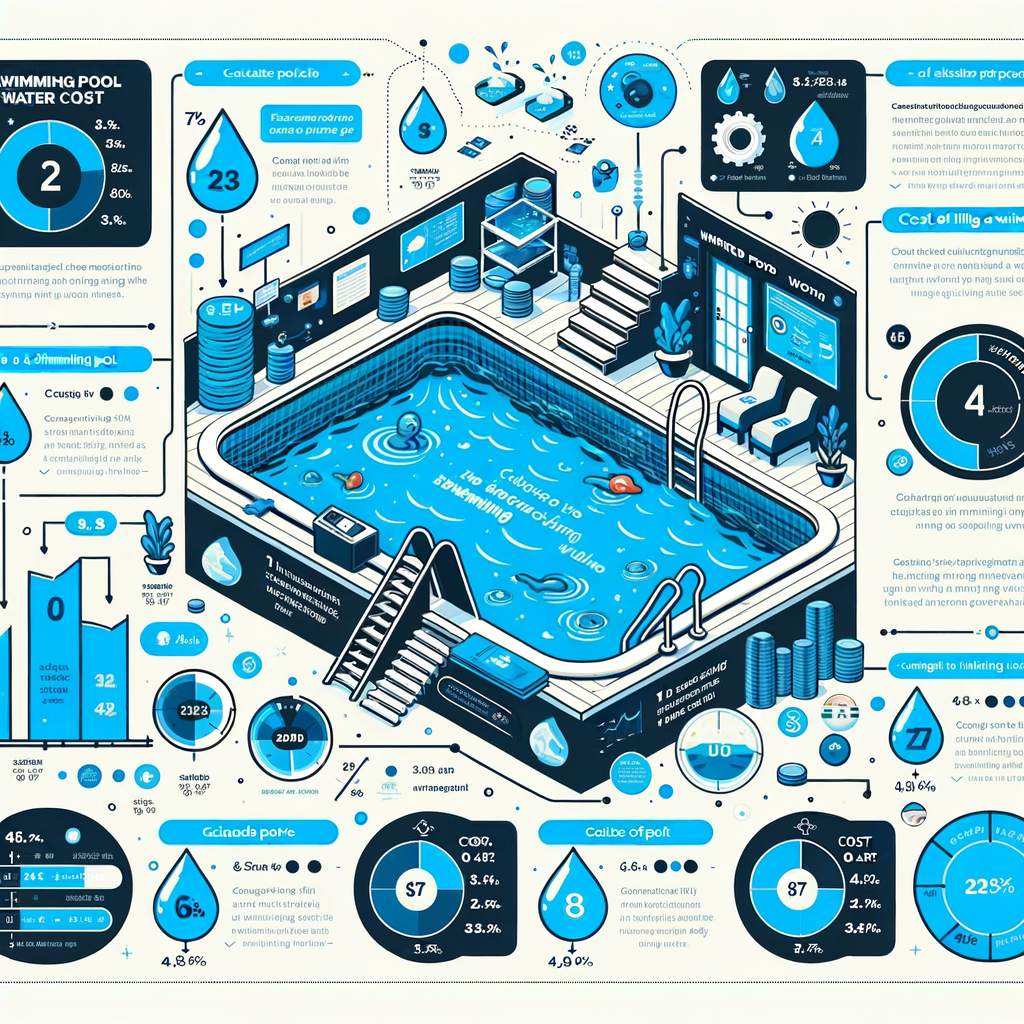
Introduction to Swimming Pool Water Cost
Swimming pools are a great source of fun and relaxation, especially during the hot summer months. However, owning a swimming pool comes with its costs, one of which is the cost of filling it with water. In this section, we will explore the basics of swimming pool water cost and the factors that affect it.
- Understanding the basics of swimming pool water cost
- Factors affecting the cost of filling a swimming pool
When it comes to filling a swimming pool, the cost of water is a major consideration. The cost can vary depending on several factors, including the size of the pool, the type of water used, and the location of the pool. On average, it can cost anywhere from $80 to $200 to fill a standard-sized swimming pool with water. This cost includes the price of the water itself, as well as the cost of delivery if you choose to have the water delivered by a water truck.
There are several factors that can affect the cost of filling a swimming pool. The first is the size of the pool. Larger pools require more water, which increases the cost. The type of water used can also affect the cost. For example, using chlorinated or saltwater may cost more than using regular tap water. The location of the pool can also affect the cost. If the pool is located in a remote area, the cost of delivery may be higher. Finally, the time of year can also affect the cost. During periods of high demand, such as the summer months, the cost of water may be higher.
In the following sections, we will delve deeper into how to calculate the cost of pool water, provide a detailed breakdown of the costs involved, and offer tips on how to save on swimming pool water expenses. So, stay tuned!
How to Calculate Pool Water Cost
Understanding the cost of filling your swimming pool with water is crucial. It helps you plan your budget and manage your resources effectively. Here’s a simple, step-by-step guide to help you calculate your pool water cost and the tools you’ll need for this calculation.
- Step-by-step guide to calculate pool water cost
Here are the steps you need to follow to calculate the cost of filling your swimming pool with water:
- Measure your pool: Determine the volume of your pool in gallons. You can do this by multiplying the length, width, and average depth of your pool, then multiplying by 7.5 (since one cubic foot of water equals approximately 7.5 gallons).
- Check your water company’s rates: Look at your water bill or contact your water company to find out how much they charge per gallon of water.
- Do the math: Multiply the number of gallons your pool holds by the cost per gallon. This will give you the total cost of filling your pool with water.
- Tools and resources for swimming pool water calculation
Here are some tools and resources that can help you calculate your pool water cost:
- Pool volume calculators: These are online tools that help you calculate the volume of your pool. You just need to input your pool’s dimensions and shape, and the calculator will do the rest.
- Water company’s website or customer service: They can provide you with the current rates for water usage.
- Calculator: A simple calculator will help you multiply the volume of your pool by the cost per gallon to get the total cost.
Remember, the cost of filling your pool is just one part of the overall cost of owning a swimming pool. Other costs include maintenance, chemicals, and energy usage. However, with careful planning and budgeting, you can enjoy your pool without breaking the bank.
Cost of Filling Swimming Pool: A Detailed Breakdown
Understanding the cost of filling a swimming pool can be complex. It involves various factors such as the size of the pool, the type of water used, and the location. In this section, we will provide a detailed breakdown of these costs through two case studies.
Cost Calculation for Pool Water: Case Study
Let’s dive into two different scenarios to understand the cost of filling a swimming pool. One is a residential pool and the other is a commercial pool. These case studies will give you a clear picture of the cost involved in filling different types of pools.
- Case Study 1: Residential Pool
- Case Study 2: Commercial Pool
Consider a standard residential pool with dimensions of 16 feet by 32 feet and a depth of 5 feet. The volume of such a pool is approximately 19,200 gallons. If we consider the average cost of water in the United States, which is $1.50 for 1,000 gallons, the total cost of filling this pool would be around $28.80.
Now, let’s consider a commercial pool with dimensions of 25 feet by 50 feet and a depth of 8 feet. The volume of this pool is approximately 93,600 gallons. Using the same average cost of water, the total cost of filling this pool would be around $140.40.
These case studies demonstrate that the cost of filling a pool can vary significantly based on its size and type. Therefore, it’s important to consider these factors when planning for a pool.
| Type of Pool | Dimensions | Volume (Gallons) | Water Cost |
|---|---|---|---|
| Residential | 16ft x 32ft x 5ft | 19,200 | $28.80 |
| Commercial | 25ft x 50ft x 8ft | 93,600 | $140.40 |
Remember, these costs are only for the water. Other costs such as maintenance, heating, and cleaning are not included in this calculation. Therefore, owning a pool can be a significant investment, but it also provides a lot of enjoyment and relaxation.
Filling Your Pool: Cost Vs Benefits
When it comes to filling your swimming pool, understanding the cost and benefits is crucial. This section will delve into the expense of pool water and the benefits of maintaining optimal water levels in your pool.
- Understanding the expense of pool water
The cost of filling a swimming pool is not just about the price of water. It also includes the energy cost for pumping the water into your pool, the cost of treating the water to keep it clean and safe, and the ongoing maintenance costs. According to the National Swimming Pool Foundation, the average cost to fill a pool is between $80 and $120, depending on the size of your pool and your location. This does not include the ongoing costs of maintaining the pool water, which can add up to several hundred dollars per year.
- Benefits of maintaining optimal water levels in your pool
Maintaining the right water level in your pool is not just about saving money, it’s also about ensuring the longevity of your pool and the safety of those who use it. When the water level is too low, it can cause the pump to run dry and overheat, leading to costly repairs. On the other hand, if the water level is too high, it can lead to water spilling out of the pool, which can damage the surrounding area and increase the risk of slips and falls.
Moreover, maintaining the optimal water level helps to ensure that the pool’s chemical balance is maintained. This not only keeps the water safe for swimmers but also helps to prevent damage to the pool’s liner and equipment.
In conclusion, while filling your pool does come with costs, the benefits of maintaining the right water level far outweigh the expense. By understanding these costs and benefits, you can make informed decisions about your pool maintenance and enjoy your pool for many years to come.
Swimming Pool Water Expense: Tips to Save
Having a swimming pool can be a great source of fun and relaxation. However, the cost of filling and maintaining the pool can add up. Here are some tips to help you save on your swimming pool water expense.
Reducing the Price of Filling Swimming Pool
Reducing the cost of filling your swimming pool is not as difficult as it might seem. It all comes down to two main strategies: regular maintenance and efficient water usage.
- Tip 1: Regular Maintenance
- Tip 2: Efficient Water Usage
Regular maintenance of your swimming pool can save you a lot of money in the long run. By keeping your pool clean and in good condition, you can avoid expensive repairs and water wastage. This includes checking for leaks, cleaning the pool regularly, and ensuring the pool’s equipment is functioning properly.
Efficient water usage is another key to reducing the cost of filling your swimming pool. This can be achieved by using a pool cover to reduce water evaporation, which can save up to 50% of water. Additionally, try to avoid overfilling your pool, as this can lead to unnecessary water wastage.
In conclusion, while having a swimming pool can be a significant expense, there are ways to manage and reduce these costs. By implementing regular maintenance and efficient water usage, you can enjoy your pool without breaking the bank.
Conclusion: Making the Most of Your Pool Water
As we reach the end of our discussion on swimming pool water cost, it’s important to reflect on the key points we’ve covered. The cost of filling and maintaining a swimming pool can be significant, but with the right knowledge and strategies, it’s possible to manage these expenses effectively.
- Final thoughts on swimming pool water cost
- Key takeaways on calculating and reducing pool water filling cost
Swimming pool water cost is not just about the initial filling. It encompasses the ongoing maintenance, including water treatment and periodic refilling. It’s crucial to factor in these costs when planning for a swimming pool. However, the joy and benefits of having a pool often outweigh the costs.
Calculating pool water cost involves considering the size of your pool, local water rates, and the frequency of water changes. To reduce these costs, consider strategies such as using a pool cover to reduce evaporation, investing in a water-efficient pool filter, and maintaining proper chemical balance to avoid frequent water changes.
Remember, while the costs associated with pool water can be substantial, they are also manageable. With careful planning and smart strategies, you can enjoy the benefits of your pool without breaking the bank. So, dive in and make the most of your pool water!














